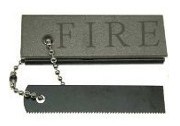 Wilderness survival is no laughing matter. Many of us may have no interest in putting ourselves in dangerous situations, but the threat of being stranded in the wild is very real. In cases where someone becomes stranded, it’s not always guaranteed that they’ll have everything they need to get through without consequence. Because of this, it’s always smart to learn some basic survival skills before facing a situation where you might need to fend for yourself.
Wilderness survival is no laughing matter. Many of us may have no interest in putting ourselves in dangerous situations, but the threat of being stranded in the wild is very real. In cases where someone becomes stranded, it’s not always guaranteed that they’ll have everything they need to get through without consequence. Because of this, it’s always smart to learn some basic survival skills before facing a situation where you might need to fend for yourself.
Fortunately, there are a lot of basic skills that can make a big difference, providing safety and comfort that could save your life. For many of these skills, we can thank Native Americans, who have been practicing and perfecting these skills for centuries. Here are a few basic survival tips that every person should know before they leave modern comforts for the wild outdoors.
Building an emergency shelter
Taking shelter in a cave or underneath a rock overhang is convenient, but not always possible. Whatever your setting, a shelter is essential to your survival, especially if you don’t know how long you will be on your own. Shelters come in several different forms, depending on what you have available to you. In regions of heavy snow, you can burrow into the snow for a makeshift cave save from the wind and offering a little insulation.
In regions with trees, branches and their leaves can provide a good framework — you can then fill in the gaps with moss, leaves and whatever else is around you. And don’t rule out the possibility of a debris shelter, which simply uses whatever materials are available — however random — and fashions them into a basic hut. With a little familiarity and practice, you can build a hut that survives several days and provides adequate coverage.
Starting a primitive fire
A flint and stone are essential to building your own fire in the wild. Find try twigs, grass, moss and other fine organic materials and shower them with sparks by striking the flint and stone together. Blow lightly on the smoldering kindling until it catches fire, then add larger twigs and branches until you have a fire fully rolling. It takes some practice to learn how to build a fire that sustains itself and provide ample warmth, but if you can do this you’ll have a source of heat, a protectant from wild animals and a means of cooking food in the wild.
Making stone tools
Stone tools are a viable replacement for hammers, knives and other equipment, but creating them is easier said than done. The most common means of making these implements is by breaking stones into shards and collecting the pieces best suited for use as tools. With a mallet head-shaped stone or a blade-like sliver of rock, you can then use twine to tie the stone to a stick handle and use it while stuck out in the wild. Plan on practicing this routinely before trying it in a real-life survival scenario.
Imparting survival knowledge at a young age
It’s never too early to teach kids basic survival skills. Many educational programs are available to help kids learn these skills while developing an appreciation for nature. In fact, some Native American tribes and organizations make an effort to pass down their time-honored survival tips to younger generations. The Chickasaw Nation, for example, teaches wilderness survival to kids through both the Slippery Falls Scout Ranch and the Chickasaw Council Boy Scouts. Ask around to see what similar programs are available in your area.
While this list of skills is by no means comprehensive, every survival tip helps. If you’re interested to learn more, invest in a wilderness survival guidebook or consider taking a class that teaches survival skills in a hands-on manner. And practice these skills periodically so that they are sharp in your mind if you ever find yourself needing to use them.









